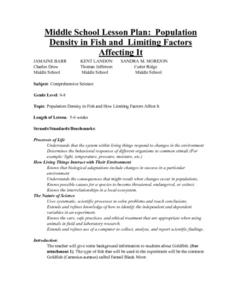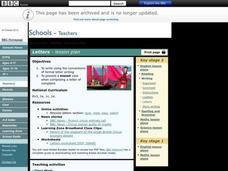Curated OER
Antarctica
Students explore why Antarctica is so important to the planet. They investigate the physical characteristics. Students create their own unique treaty of governance for Antarctica and discuss how laws are enforced in Antarctica.
Curated OER
Save the _____ Story Board
Young scholars research an endangered species. They examine statistics, characteristics, and information about the species. Students play "webmaster" and design a site that will help to save an endangered species.
Curated OER
The Seven Characteristics of Life
Third graders investigate the characteristics of living and nonliving things. They conduct a research quest in order to identify the seven characteristics of life. Then students pick one aspect and use it to create a song meant to be...
Curated OER
Heat Misconceptions
Third graders determine that gloves do not provide heat, but rather, they insulate or hold in any heat that is in their hand. They discuss the different temperatures found in ecosystems around the world. What do animals that live in...
Curated OER
Population Density In Fish
Students investigate how a population of fish multiplies in an ecosystem and the kinds of things that must be done to maintain a healthy population balance with other organisms that live there. They conduct an experiment to test the...
Curated OER
Japanese Carp Kites
Students listen to the story A Carp for Kimiko and discuss its theme/lesson. Then they identify and are introduced to the Japanese holiday, Children's Day, formerly known as Boy's Day. Students also design and create their own carp kite....
Curated OER
Coral Reefs: Gardens Under the Sea
Students discover the wonders of coral reefs while listening to a book about them. In a Reading Rainbow video activity, they simulate a dive, check equipment and explore a reef. Role-playing as marine biologists, students uncover...
Curated OER
Fishes
In this fish worksheet, students will review the characteristics of fish by comparing the jaws, skeleton, and fertilization of each fish class. Then students will use a phylogenetic tree to compare the groups of fish to ancestral...
Curated OER
Eat and Run
Students 'browse' like a deer, demonstrate how deer react when danger appears, demonstrate survival of the fittest, identify 4-5 sources of danger to deer and describe 1-2 ways deer protect themselves.
Curated OER
Factual Writing: Letters
Students write a business letter. In this factual writing lesson, students complete an online activity. Groups also draft a reply to a complaint letter. A worksheet is included for extra practice.
Curated OER
Unit 9 Trigonometry
In this trigonometry worksheet, students find the lengths of triangles. They construct triangles and spirals. Students complete indirect measurement problems. They find the distance between objects and determine the volume of rectangular...
Curated OER
Habitat Hunt
Third graders read several nonfiction texts and practice finding the main idea for the text as well as learn about various habitats. In this main idea lesson, 3rd graders read several nonfiction texts and make habitat cards. Students...
Curated OER
Prepositions Test
In this using prepositions worksheet, students read 20 incomplete sentences. Then students complete the sentences by adding the correct preposition to each sentence.
Curated OER
Desert Tortoise Adaptations
Students observe the Desert Tortoise in its natural surroundings. For this adaptations lesson, students study and take pictures of an animal in its habitat, then design a PowerPoint which addresses adaptations, biodiversity, and threats...
Curated OER
Life Cycles in Action - Flip Book
Young scholars create a flip book to depict animal and plant life cycles. In this life cycle lesson, students discuss life cycles. Young scholars receive a plant or animal and pictures of its life cycle. Students color the pictures and...
Curated OER
Five Little Frogs
Students explore the concept of counting using music. In this counting lesson, students use the song "Five Little Frogs" and the felt board set to discover one to one counting. Students repeat the song as they watch and role play with...
Curated OER
World Wetlands Day
In this World Wetlands Day worksheet, students read or listen to a passage, then match phrases, fill in the blanks, choose the correct words, unscramble words and sentences, put sentences in order, write discussion questions and conduct...
Curated OER
Paper Bag Skits
Learners discover math measurements by creating a skit with classmates. In this geometry lesson, students utilize objects in a paper bag and index cards to create a short skit focusing on debate over the size of the objects. Learners...
Curated OER
All About Birds
In this birds worksheet, students click on the links in the questions about birds to find the answers to the questions and then come back and answer the questions. Students answer 7 questions total.
Curated OER
What is the Function of Each Seed Part in the Growth of a Plant
Sixth graders investigate the parts of a seed by using a digital camera. In this botany lesson, 6th graders plant their own seeds in class and demonstrate the necessary attributes for growing a plant. Students utilize a camera to...
Curated OER
Owen
Young scholars read Owen by Kevin Henkes. For this literature lesson, students listen to the story and compare it to other Kevin Henkes books. They answer comprehension questions and bring their own treasured item to share.
Curated OER
A Weekend With Wendell
Young scholars complete activities with the story A Weekend With Wendell by Kevin Henkes. In this literature activity, students listen to the story and answer comprehension questions. They compare this story and its characters to other...
Curated OER
Scavenging the Sandy Shore
Students explore oceanography by examining a beach. In this living things lesson, students define the terms abiotic and biotic and practice identifying living and non-living things that have been previously found on a beach. Students...
Curated OER
Beaver Succession Mural
Young scholars explore the concept of beaver pond succession. In this succession lesson, students discuss what succession is and how it works. Young scholars create a mural to present their understanding of this concept.

























